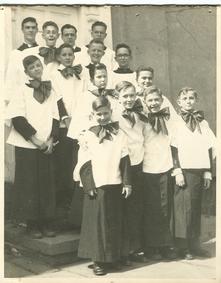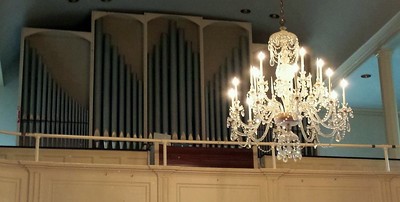Overlooking the Hudson River, St. George’s, whose home is the oldest church building in the city of Newburgh, has served our community since before the American Revolution. At first a mission church of St. Thomas’, New Windsor, St. George’s received its royal charter from George III in 1770.
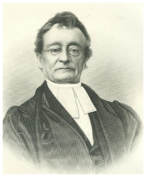
Much of St. George’s early history was recorded in the diaries of the Rev. Dr. John Brown, who became rector in 1815 and served an astonishing 63 years. As a missionary priest on horseback he established numerous Hudson Valley churches: St. John’s Monticello, Grace Middletown, Christ Marlboro and St. John’s Cornwall. He also revived the Episcopal churches in Goshen, Walden, Peekskill, Garrison and Milton. A tireless shepherd, the Rev. Dr. John Brown’s devotion to sharing the Gospel also led him to build our current church. Construction (with the help of church members who hauled stones from a local quarry during many “stone bees”) began in 1817 and the completed Federal-style building was consecrated on November 10, 1819, just in time for the 28-year-old rector’s own wedding five days later!

Photo by Susan DeMark, Mindful Walker
In 1838, the Rev. Dr. Brown also directed the creation of St. George’s Cemetery, located on Washington Street. Assisted by his friend, landscape architect Andrew Jackson Downing, Brown planned a sylvan final resting place for people of all races and religious affiliations. Today dedicated volunteers work throughout the year to maintain and restore the cemetery and its memorials, gates and fences. To reduce vandalism, the main gate is now kept locked, but you may make an appointment for access to its grounds by calling the church office at 845 561 5355. If you are doing genealogical research, you may also call the office to arrange to obtain information from the complete records of burial sites dating back to the 1800s.
In 1874, the Rev. Dr. Brown and the women of St. George’s organized a home for the aged and a hospital known as St. Luke’s at the corner of Dubois and Third Streets, which later moved to Liberty Street near Broadway. Gradually the hospital administration was turned over to the wider community. As that community grew, so did the hospital, relocating in 1909 to its current Dubois St. location. Today known as Montefiore St. Luke’s Cornwall Hospital, it continues the legacy of service begun by St. George’s.
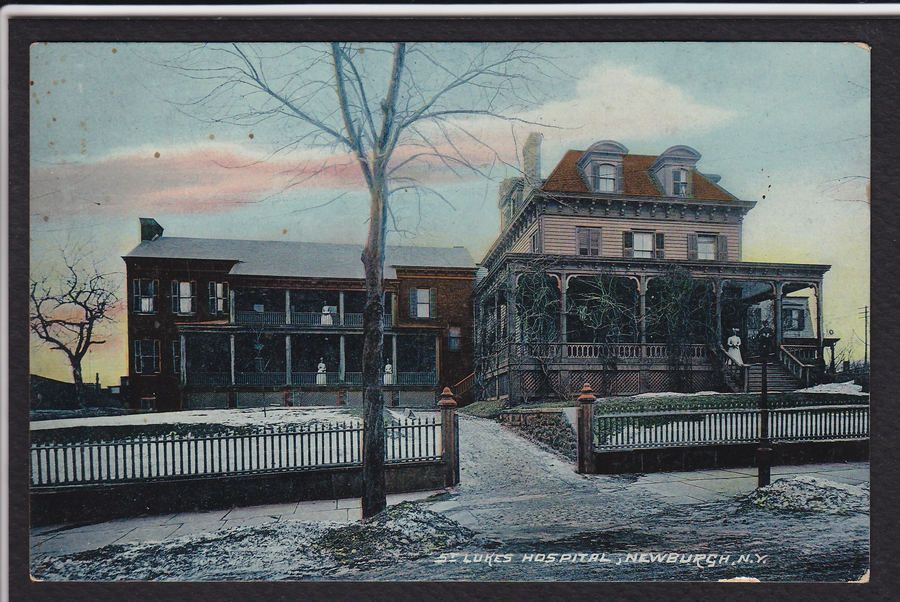
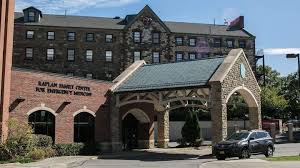
Inspired by Brown’s extraordinary determination and accomplishments, the parish continued to grow throughout the 20th century. St. George’s held fast to its mission in spite of the devastation wrought by Newburgh’s failed Urban Renewal program of the late 1960s and early 1970s when much of Newburgh’s East End vanished. Located in the middle of Newburgh’s Historic District (New York State’s second largest) and unlike a number of neighboring religious congregations that abandoned the city for the suburbs in the mid-twentieth century, St. George’s remains committed to providing a spiritual home to all in the heart of the city.
Believing that all humans are made in the image of God, we have supported changes within our diocese and national church, welcoming the ordination and consecration of female, lesbian, gay, bisexual and trans priests and bishops. St. George’s honors our spiritual ancestors’ legacy of ministry through our weekly Food Pantry, service at Shepherd’s Kitchen Lunch Program, Girl Power empowerment program for adolescent girls, and Habitat for Humanity’s Episco-build, as well as our support of the Episcopal Diocese of Jerusalem, the Seamen’s Church Institute, and St. Luke’s School in Martel, Haiti. Echoing our forebears’ role in providing healthcare, St. George’s is honored to count among our members a number of nurses, nurse educators, shelter coordinators, and physicians. Nourished by the Gospel’s lessons, individual members volunteer with community organizations such as Rotary International and the Newburgh Armory Unity Center, as well as City of Newburgh government. Today we are excited to be active participants in the renaissance of our beautiful, resilient, welcoming river city!
The Buildings
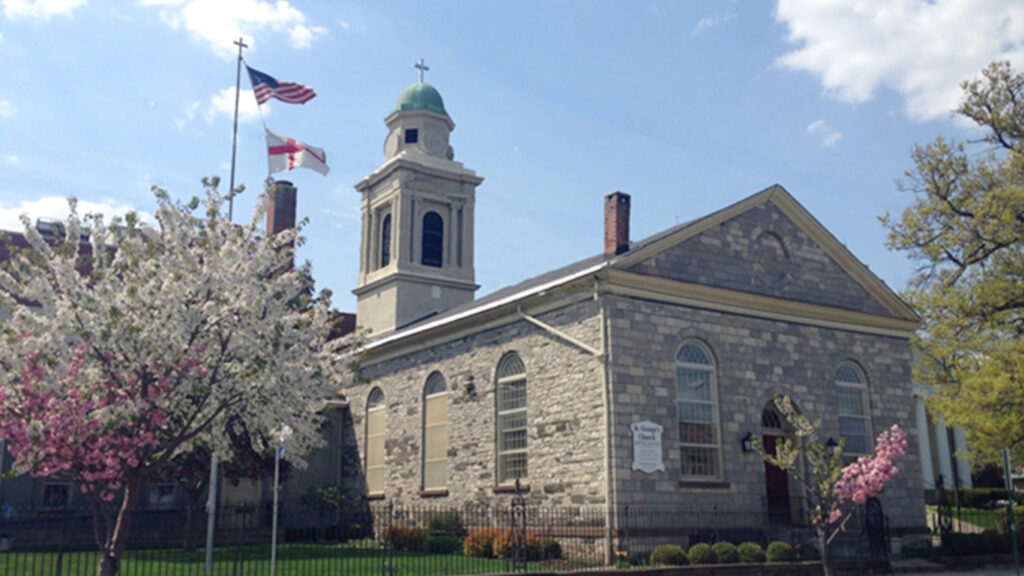
The original building was a square stone design with clear glass windows. The four nearest Grand Street are original. The gallery was added in 1827 when the first organ was also installed. Two lots at the south side were purchased in 1830 and in 1832 the iron fence was obtained from Trinity Church, New York City. In gradual stages additions for parish activities and offices were built in the 20th Century. In 1835 the sanctuary was enlarged toward the west end and a bell tower was constructed.
At that same time the Reverend Dr. Brown began plans for his house to built on First Street on the grounds of his garden In 1836 the bell was installed (subsequently a new one was installed in 1849), as was the Baptismal Font, which was presented to the church by Trinity Church, New York City.
Stained Glass Windows
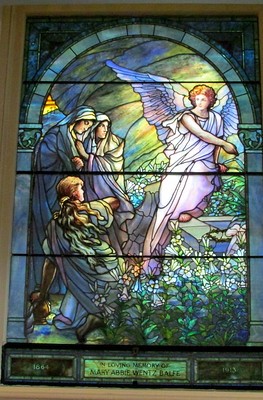
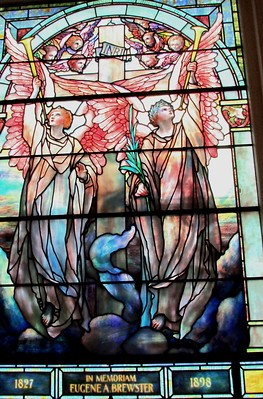
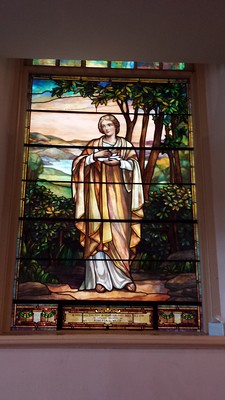
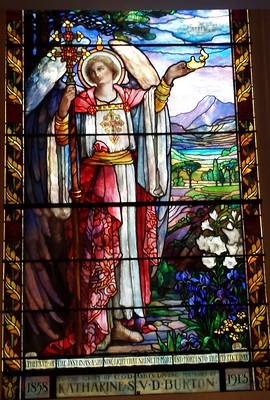
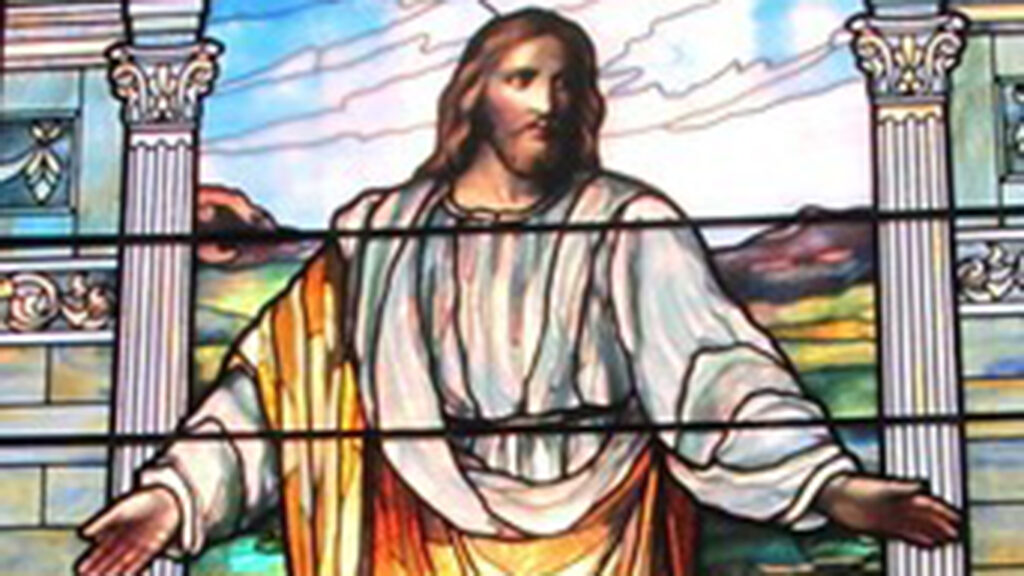
The earliest record of a stained glass window is noted by a parishioner in 1860. In the chancel was a large window of red, green, blue and white colored glass. It was irreverently called “The Holy Patchwork.” The window was broken in 1857 and although it was repaired, it was replaced in 1880 with the present triptych window depicting the Ascension of Jesus. This was purchased in England, as were the two angels that flank this majestic window.
The American stained glass windows are amongst St. George’s treasurers. Installed in the first decade of the twentieth century, the five windows in the nave are made of a distinctly American invention – opalescent glass. Two were made in the Tiffany Studio. In 1998 three of the windows were removed to repair the damage that had been done by excessive mold and heat.
Today the interior of the church, which is a distinctive federal style, glows as the brilliant light from the colored glass windows plays on the white walls and pews. In the chapel that adjoins the sanctuary, the walls are adorned by English stained glass windows depicting the life of Christ and a number of saints. These windows were brought to St. George’s when St. Paul’s Church, which was two blocks north on Grand Street, was closed.
The Music Tradition
Throughout the past century, St. George’s has enjoyed a reputation for fine music both instrumental and vocal. Today the choir and organ are situated in the east gallery. The organ was built by the Gress-Miles Organ Company. It is baroque in style and contains 19 voices, 27 ranks and 1552 pipes. Today, a Baldwin piano in the sanctuary complements worship and musical performances.

